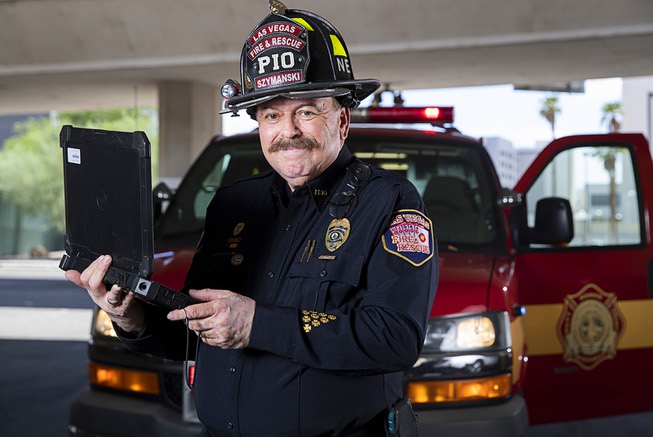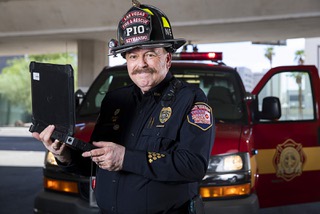
Tim Szymanski, public education and information officer for Las Vegas Fire and Rescue, poses in front of his van after an interview at Fire Station 1 in downtown Las Vegas Tuesday, August 2, 2022. Szymanski will retire on August 18 after a more than 50-year career in firefighting. Szymanski came to Las Vegas in 1996.
Wednesday, Aug. 10, 2022 | 2 a.m.
As Tim Szymanski sat in a meeting room inside Las Vegas Fire & Rescue’s headquarters early last week, a trio of firefighters caught wind he was giving away his office mementos and couldn’t resist asking what treasures might be available.
There’s a lot to give away, Szymanski admitted.
That’s what happens when you spend more than a half-century in firefighting — which for him includes stints ranging from small-town firefighter and paramedic for his hometown in suburban Ohio to becoming Atlanta Fire Department’s chief media liaison during the 1996 Olympics.
“Well, if there’s anything in there and you want it, show me what it is and you can have it,” Szymanski said, which brought a smile to the firefighters’ faces. “There are some helmets hanging on the wall. They’re going to hit the dumpster if somebody doesn’t take them.”
He will retire as Fire & Rescue’s public information officer Aug. 18 after more than 26 years at the department, where he will be remembered as a stalwart among city officials and local media outlets.
The job of public information officer has changed drastically over Szymanski’s tenure in Las Vegas, as has the nature of firefighting itself, he said. That includes a career that’s seen the rise of computers, smartphones and social media — most of which were nonexistent when he was brought on as a firefighter for the Cleveland suburb of Northfield after graduating from high school in 1970.
Back then, first aid was so archaic that CPR or mouth-to-mouth resuscitation wasn’t yet standard practice. Essential tools like the “Jaws of Life” hydraulic rescue tool were in their infantile stages, and the bulk of house fires were caused by cigarette burns, Szymanski said.
As a self-described history buff, it’s been fascinating to see how life for most Americans has changed since the 1970s, Szymanski said.
Now, departments like Fire & Rescue use ultramodern technology like cameras that see through smoke. And while most house fires are still caused by smoking, now it’s marijuana — not tobacco — causing the bulk of blazes, he said.
These days, fire control throughout the valley has become so effective that most blazes are out by the time Szymanski arrives to the scene, he said. That’s especially true of the Strip, where sprinkler systems and other mechanisms were adopted by most resort operators after the historic 1980 fire at the MGM Grand, which killed 85 and remains one of the deadliest hotel fires in modern American history.
“The Strip and downtown have never been a problem,” Szymanski said. “I tell people that this is probably one of the most safest cities in the world. And it’s because all those buildings since the MGM and Hilton (fires), we can go to a fire in one of those buildings and 99.9% of the time they’re out.”
Even before the 2017 mass shooting at the Route 91 Harvest festival, Fire & Rescue was trained to deal with active shooter events, and the department’s response was over within two hours of the deadliest mass shooting in U.S. history.
“It’s because we practice all the time,” Szymanski said. “When it comes to fire and medical response, there is no better place in the country to live than right here. I tell people this is almost like Disneyland for a firefighter here.”
That mix of life and institutional knowledge make someone like Szymanski invaluable. And for that, he’ll be greatly missed, Las Vegas Mayor Carolyn Goodman said.
“Tim Szymanski has served 26 years with Las Vegas Fire & Rescue and has become well known for providing accurate and timely information to our citizens and visitors,” Goodman’s office told the Sun in a statement. “We thank him for all his work, and wish him the best as he moves on to the next chapter of his life in retirement.”
‘My Jesus talk’
Szymanski’s life likely would have been much different if it hadn’t been for a plane that crashed in his Northfield, Ohio, backyard shortly after he graduated from high school.
Before then, he was a cadet for the local Civil Air Patrol’s Search & Rescue team with ambitions of becoming a deputy sheriff somewhere. When that plane crashed, he and his team were tasked with securing the area until Federal Aviation Officials could arrive to investigate.
The Northfield Fire chief told Szymanski he should join the department and give up his dreams of becoming a cop, he said. He mulled the move and ultimately agreed, and he worked in Ohio for the next eight years before moving to Gwinnett County, Ga., just adjacent to Atlanta’s Fulton County.
“I tell everybody that was the day I got my Jesus talk,” Szymanski said. “I quit going to cadet classes and concentrated on the fire service.”
There, Szymanski served as an EMT and engineer until 1983, when the county’s assistant chief asked him to serve as the incoming chief’s aide. Well, he said, he served the new chief so well that he was asked to serve as the department’s first spokesman and PIO.
Only a few fire departments in the country at the time had a dedicated flak to deal with reporters. In its early stages, the job was self-explanatory: He would accompany fire crews and explain to journalists at the scene what was happening. Eventually, he started sending press releases.
Interviews with TV stations or press releases don’t seem like big deals today, but these approaches became invaluable in getting vital information out to the public, Szymanski said.
“Back then, officials would always say no comment and we wouldn’t let (media members) on the scene,” Szymanski said. “My chief said he wanted us to be proactive with the news media and tell them what we do and stuff like that.
“So Istarted going on calls and when the news media would show up, I would stick them together and start explaining things like what it was the firefighters were doing, and they just couldn’t believe it. Here’s a guy here that’s willing to work with us and give us the facts.”
In 1987, Szymanski became the fire chief in Winder, Ga., a town about an hour away from Atlanta. It was a fun job, but it wasn’t something he envisioned doing for long, he said. So in 1992, he accepted an offer to be the Atlanta Fire Rescue Department’s public information officer for the 1996 Olympics.
“Atlanta was a great learning experience,” he said. “They had the whole downtown area closed and a bunch of streets closed down. You had to be checked by military police and all that.… the biggest thing we were worried about was terrorism. We were getting like 200 bomb threats a day. We were just running the wheels off the car going on calls.”
As part of his duties while working in Atlanta, he’d speak to other departments about media relations, and he piqued the interest of former Las Vegas Fire & Rescue chief Clell West while the two were at a conference in Nashville, Tenn., just a few months before the opening ceremonies.
Clell had vowed to hire a public information officer before he retired, and the department went on a national search to find the right fit, Szymanski said. Fire & Rescue officials reached out to Szymanski, and, after secretly flying out to Las Vegas to scope out the city and meet with officials for the job, he accepted the job offer on the caveat he started after the Summer Games had concluded.
Firsthand victim
Szymanski has witnessed hundreds of fires in his career. In 2013, one hit home for him. An exhaust fan in the upstairs bathroom of Szymanski’s home caught fire while he and his wife, Ellen, were running errands. They were in the car when they got a call from Fire & Rescue advising them of the blaze.
“She just started screaming,” he said of his wife. “We didn’t need a siren to get there.”
By the time the Szymanskis returned home, the fire was out but the damage was done. Water bulged from the ceiling. Several rooms upstairs were destroyed. But if he learned anything from that experience, it was how to better help folks who had to deal with their life going up in smoke.
“So a lot of times I would go to a house after a fire and I would sit and explain the process,” of making insurance claims and navigating the bureaucracy that comes with such an event. “Most people never have a fire in their home. They don’t know what to expect.”
On one hand, Szymanski said, going through a house fire himself was incredibly insightful. On the other hand, however, it’s never a good look when you’ve been fighting fires as long as he has. He even crafted the news release documenting the fire.
“I even made the front page of the LA Times,” he said. “They said the guy who’s teaching people how to be safe from fires, his whole house catches on fire.”
Szymanski ultimately made it a learning experience by inviting local news outlets into what remained of his home to show reporters what happens during a fire and how it can damage the home’s foundation. It was access reporters couldn’t get anywhere else.
“Well, I figured, if you’re dealt lemons, make lemonade, you know?” Szymanski said.
Budding novelist
As for what’s next, there’s a lot to still be determined, Szymanski said.
He’s putting the finishing touches of a book on the history of Fire & Rescue, he said. With that project, he’s sent the draft to the publisher’s design team and is waiting for final approval. And he also has other literary plans in the works.
Without divulging too much, Szymanski said he’s workshopping a fictitious romance novel, and already has a few chapters done. You won’t find a preview here, not yet at least. But Szymanski did say, fittingly, the protagonist is a firefighter.
“My scenes aren’t steamy enough, I don’t know how to write it,” Szymanski said. “It’s so bizarre, writing two or three hours, and I just keep writing it. I’m not gonna tell anybody about it or anything.”
Literary feats aside, Szymanski said he and his wife, Ellen, will likely move back to the Atlanta area in the near future. The two met in high school back in Ohio, but he and Ellen have always thought of Atlanta as their home, he said.
What Szymanski is looking forward to the most will be the chance to spend time with his family, as well as eat and sleep uninterrupted with Ellen — all of which he’s seldom done over the last 51 years.
“It just seemed like every night we were getting woken up,” Szymanski said. “There were a lot of times I’m out there saving the world and everything and my wife was home alone with the little kids (who are now adults). I was always gone when the bad stuff was hitting the fan.
“A lot of people tell me I did a really great job. Yeah, I did, 50 percent. The other 50 percent was my wife. She was at my back the whole time and she supported me.”
But what Szymanski will miss most is the dignity that came with wearing a badge.
“It’s going to kill me not being able to say I’m a firefighter,” Szymanski said. “It’s going to hurt. Everybody says you’ll always be a firefighter, but it’s not the same.I was just really proud of telling people I was with the fire department.”

